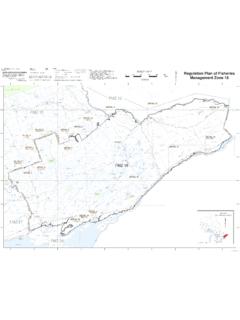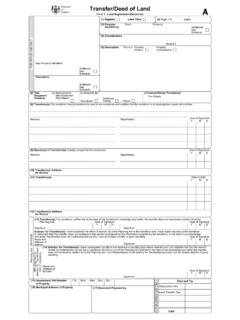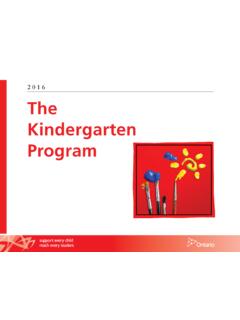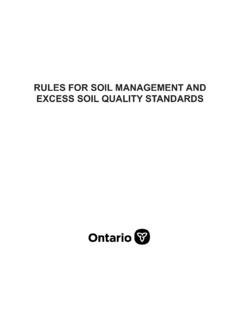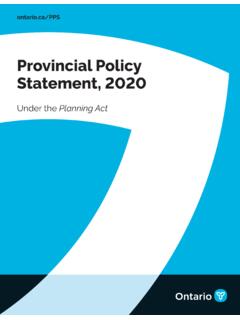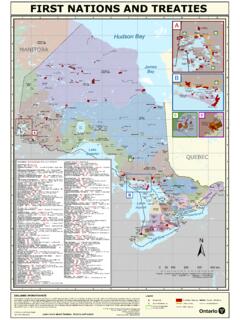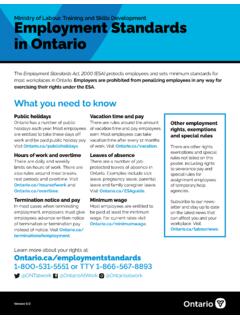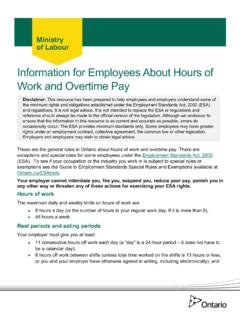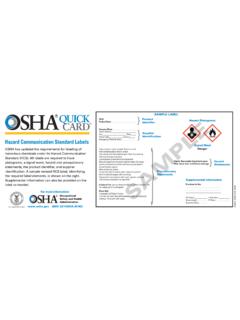Transcription of Workplace Hazardous Materials Information System (WHMIS)
1 July 2017 A Guide to the LegislationWorkplace Hazardous Materials Information System ( whmis )Disclaimer: This resource has been prepared to help the Workplace parties understand some of their obligations under the Occupational Health and Safety Act (OHSA) and regulations. It is not legal advice. It is not intended to replace the OHSA or the regulations. For f urther Information please see full disclaimer at This g uide is also available online at A hard copy of this publication can be ordered: online at any time at b y phone through the ServiceOntario Contact Centre Monday to Friday, 8:30 am to 5:00 pm 416- 326 -5300 416-325 -3408 (TTY) 1- 800- 668 -9938 toll- free across Canada 1- 800- 268 -7095 TTY toll- free across Ontario ISBN 978-1- 4868-0400 -9 (Print) Rev.
2 07/17 ISBN 978-1- 4868-0401 -6 (HTML) ISBN 978-1- 4868-0402 -3 (PDF) Queen s Printer for Ontario, 20172 Table of Contents Introduction .. 51. whmis 1988 to whmis 2015 Mak ing the transition .. 6 Phase 1 .. 6 Phase 2 .. 6 Phase 3 .. 7 During the transition .. 82. The whmis legislation .. 9 Federal whmis 9 Onta rio s whmis legislation .. 10 Enforcing whmis legislation .. 11 whmis and the transportation of dangerous goods .. 113. whmis and the supplier .. 12 General duties .. 12 Classification .. 13 The supplier label .. 15 The supplier safety data sheet .. 18 Exemptions from the federal whmis legislation .. 214. whmis and the employer .. 24 General duties.
3 24 Labelling and identification .. 25 Safety data sheets (SDS).. 30 Worker education .. 333 Assessing employer-produced products .. 38 Hazardous products exempt from whmis .. 385. whmis and the worker .. 41 The worker s right to know about hazards .. 41 The worker s responsibilities .. 416. Special applications of whmis .. 42 Laboratories and laboratory samples .. 42 Construction projects .. 447. Confidential business Information .. 48 CBI legislation .. 48 Employer s claim for exemption .. 49 Appeals .. 53 Appendix 1: whmis supplier label .. 54 Appendix 2: whmis 2015 pictograms .. 57 Appendix 3: whmis supplier Safety Data Sheet r equired content (Schedule 1 HPR).
4 59 Appendix 4: Employer compliance checklist .. 63 Appendix 5: Resources for whmis 2015 .. 664 Introduction The Workplace Hazardous Materials Information System ( whmis ) is Canada s national standard for communicating Information about Hazardous Workplace products. It is implemented through complementary federal, provincial and territorial laws. Originally established in 1988, the purpose of whmis is to ensure employers and workers receive consistent and comprehensive health and safety Information about the Hazardous products they may be exposed to at work. By setting standards for the type and amount of Information to be given to the users of Hazardous chemicals and biological agents, whmis is intended to reduce Workplace injuries and illnesses related to such products.
5 The main elements of whmis are: Product classification products intended for use in the Workplace are classified based on their Hazardous properties. Labels provide basic Information that a worker needs to know to safely use a Hazardous product. Safety data sheets (SDSs) supplement the label with more detailed Information about a product s physical and chemical characteristics, its Hazardous properties and necessary handling precautions. Worker education ensures workers understand the Information on labels and safety data sheets and can apply this knowledge on the job. This guide is intended to give Workplace parties a basic understanding of whmis and to direct readers to more detailed Information , if needed.
6 5 1. whmis 1988 to whmis 2015 Making the transition whmis is changing to adopt new international standards for classifying Hazardous Materials and providing Information on labels and safety data sheets. These new standards are part of the globally harmonized System for the Classification and Labelling of Chemicals (GHS) being phased in across Canada between February 2015 and December 2018. The GHS standards have been endorsed by the United Nations. They are also being implemented in many other countries including the United States, Australia, New Zealand, China, Japan and members of the European Union. The original whmis requirements are generally referred to as whmis 1988 and the new ones are called whmis 2015.
7 To give suppliers, employers and workers time to adapt to the new System , the transition from whmis 1988 to whmis 2015 has been taking place in three phases. Phase 1 Phase 1 began on February 11, 2015 and ends on May 31, 2018. During Phase 1: suppliers who are chemical manufacturers or importers may sell Hazardous products with either whmis 1988 or whmis 2015 labels and safety data sheets; and, e mployers may receive and use Hazardous products with either whmis 1988 or whmis 2015 labels and safety data sheets. Phase 2 Phase 2 begins on June 1, 2018 and ends on August 31, 2018. During Phase 2: chemical manufacturers and importers must comply with the whmis 2015 requirements for labels and safety data sheets; suppliers who are chemical distributors may continue to sell Hazardous products with either whmis 1988 or whmis 2015 labels and safety data sheets; and, employers may continue to receive and use Hazardous products with either whmis 1988 or whmis 2015 labels and safety data sheets.
8 6 Phase 3 Phase 3 begins on September 1, 2018 and ends on November 30, 2018. During Phase 3: the transition period for suppliers and distributors is over they must be in full compliance with whmis 2015 requirements for labels and safety data sheets; employers should only receive Hazardous products with whmis 2015 labels and safety data sheets; and, e mployers will have these final six months of the transition to bring their existing inventories of Hazardous products into compliance with whmis 2015. By December 1, 2018, the transition to whmis 2015 must be complete for all parties. There should be no Hazardous products in the Workplace with whmis 1988 labels and safety data sheets.
9 Phases of whmis transition Phases Timing Manufacturers and importers acting as suppliers Distributors acting as suppliers Employers Phase 1 February 11, 2015 to May 31, 2018 Comply with whmis 1988 or whmis 2015 Comply with whmis 1988 or whmis 2015 Comply with whmis 1988 or whmis 2015 Phase 2 June 1, 2018 to August 31, 2018 Comply with whmis 2015 Comply with whmis 1988 or whmis 2015 Comply with whmis 1988 or whmis 2015 Phase 3 September 1, 2018 to November 30, 2018 Comply with whmis 2015 Comply with whmis 2015 Comply with whmis 1988 or whmis 2015 End Date December 1, 2018 Comply with whmis 2015 Comply with whmis 2015 Comply with whmis 2015 7 During the transition For an individual Hazardous product, both the label and safety data sheet must comply with either whmis 1988 or whmis 2015, not a combination.
10 For example, it would not be acceptable for a supplier to sell, or an employer to use, a Hazardous product with a 1988 label and a 2015 safety data sheet. Employers must ensure that workers are trained on products compliant with whmis 198 8 requirements for as long as they are still used in the Workplace and on Hazardous products with whmis 2015 labels and safety data sheets as soon as practicable after the y enter the Workplace (and, in some cases, before they are used). The type and amount of training will depend on whether a product is new to the Workplace and/or newly classified as a Hazardous product. If the product is a controlled product (the previous name for a Hazardous product) under whmis 1988 and is already used in the Workplace , workers should already be trained to work with it safely.
